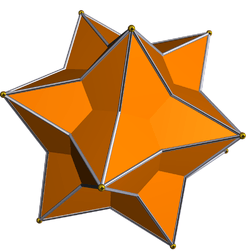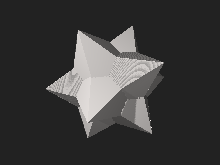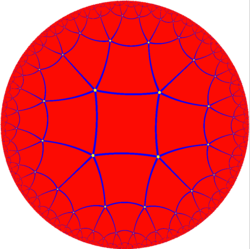Medial rhombic triacontahedron
In geometry, the medial rhombic triacontahedron (or midly rhombic triacontahedron) is a nonconvex isohedral polyhedron. It is a stellation of the rhombic triacontahedron, and can also be called small stellated triacontahedron. Its dual is the dodecadodecahedron.
| Medial rhombic triacontahedron | |
|---|---|
 | |
| Type | Star polyhedron |
| Face |  |
| Elements | F = 30, E = 60 V = 24 (χ = −6) |
| Symmetry group | Ih, [5,3], *532 |
| Index references | DU36 |
| dual polyhedron | Dodecadodecahedron |

Its 24 vertices are all on the 12 axes with 5-fold symmetry (i.e. each corresponds to one of the 12 vertices of the icosahedron). This means that on each axis there is an inner and an outer vertex. The ratio of outer to inner vertex radius is , the golden ratio.
It has 30 intersecting rhombic faces, which correspond to the faces of the convex rhombic triacontahedron. The diagonals in the rhombs of the convex solid have a ratio of 1 to . The medial solid can be generated from the convex one by stretching the shorter diagonal from length 1 to . So the ratio of rhomb diagonals in the medial solid is 1 to .
This solid is to the compound of small stellated dodecahedron and great dodecahedron what the convex one is to the compound of dodecahedron and icosahedron: The crossing edges in the dual compound are the diagonals of the rhombs. The faces have two angles of , and two of . Its dihedral angles equal . Part of each rhomb lies inside the solid, hence is invisible in solid models.
|
Convex and medial rhombic triacontahedron (both shown with pyritohedral symmetry) and on the right the dual compound of Kepler–Poinsot solids |
Orthographic projections from 2-, 3- and 5-fold symmetry axes |
Related hyperbolic tiling
It is topologically equivalent to a quotient space of the hyperbolic order-5 square tiling, by distorting the rhombi into squares. As such, it is topologically a regular polyhedron of index two:[1]

Note that the order-5 square tiling is dual to the order-4 pentagonal tiling, and a quotient space of the order-4 pentagonal tiling is topologically equivalent to the dual of the medial rhombic triacontahedron, the dodecadodecahedron.
References
- Wenninger, Magnus (1983), Dual Models, Cambridge University Press, ISBN 978-0-521-54325-5, MR 0730208
- The Regular Polyhedra (of index two), David A. Richter
External links
- Weisstein, Eric W. "Medial Rhombic Triacontahedron". MathWorld.
- David I. McCooey: animation and measurements
- Uniform polyhedra and duals
%2C_size_m_(crop_matching_medial)%2C_pyritohedral.png)
%2C_size_m_(crop)%2C_pyritohedral.png)
%2C_thick.png)
%2C_size_m%2C_2-fold.png)
%2C_size_m%2C_3-fold.png)
%2C_size_m%2C_5-fold.png)